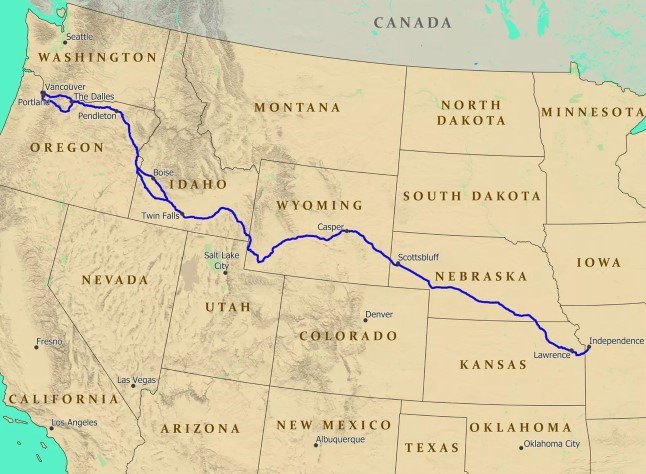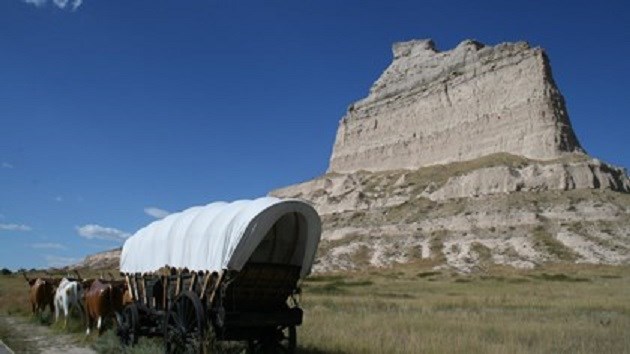Last updated: March 17, 2023
Article
Travel Blog: The Oregon Trail

NPS Gallery *Images credited to NPS without any copyright symbol are public domain.
Idaho
The trail begins at Upper Independence Landing at the intersection of East Kentucky Road and North River Boulevard in Independence, Missouri. The trail meanders across Kansas, Nebraska, Wyoming, and into Idaho. Stop by the National Oregon/California Trail Center in Montpelier, Idaho to experience a simulated covered wagon train experience or visit a recreated mercantile and gun shop. Continuing west, visit Massacre Rocks State Park in American Falls, Idaho, named after an intimidating cluster of boulders through which the narrow trail passes. Hike or bike part of the historical trail, stop to observe the wildlife, or stay overnight at the park’s campground after a day of boating and fishing. Camping is also available at the nearby Craters of the Moon National Park. A 230-mile spur trail utilizing traditional Shoshone migration routes through craggy lava flows meanders through the park. Today part of the trail remains visible from US-20.

NPS Gallery *Images credited to NPS without any copyright symbol are public domain.
Crossing into modern-day Oregon, visit the Tamástslikt Cultural Institute near Pendleton, Oregon. This facility is the only Indigenous owned-and-operated museum and research center along the Oregon Trail, providing space for the Cayuse, Umatilla, and Walla Walla people to tell the story from their perspective. Celilo Falls, located just west of Biggs Junction, Oregon is a culturally significant fishing site for Native tribes who have harvested salmon under the falls for over 10,000 years. The site eventually became a hub for an Indian trade network before being submerged under water after the construction of the Dalles Dam in 1957. Today, traditional fishing practices continue via fishing platforms, despite the tragic loss of the important landmark. The End of the Oregon Trail Interpretive Center in Oregon City, Oregon, houses educational resources on the local Native tribes, settlement of the region, and stories from the trail. Outside, visit the heirloom rose and heritage garden, as well as monuments marking the official end of the Oregon Trail. Head inside to watch the film “Bound for Oregon” or visit the interactive exhibits. The facility also offers a seasonal interpretive guided tour to learn hands-on about wagon packing, frontier camping, and more.
Washington
Heading North, stop by Fort Vancouver National Historic Site in Vancouver, Washington. Formerly a hub for the British owned Hudson’s Bay Company, this site played an important role in westward settlers. The outpost’s chief factor at the time, Dr. John McLoughlin, provided resources and shelter to American emigrants in need as they concluded their long travels. Items unearthed from this time are housed at the site’s museum. As thousands of settlers poured into the region, life was disrupted for the Indigenous peoples who lived here for generations. The Cayuse Nation of modern-day Washington was one of many tribes who were at risk of being displaced from their ancestral lands while being unknowingly subjected to outside disease. Unfortunately, as tensions rose, many lives were lost in 1847 during an altercation that is often referred to as the Whitman Massacre. Among those killed were Marcus and Narcissa Whitman, religious missionaries and the namesake of the Whitman Mission National Historic Site. Click here or visit the historic site in Walla Walla, Washington to learn more about how this event impacted Native Americans living in the region.
Keeping the Story Alive
While the Oregon Trail story often focuses on Euro-American settlement of the region, it is important to recognize the Native tribes who lived and continue to live here today. National Historic sites such as Tamástslikt and the Whitman Mission help keep their stories alive. To read more about the stops along Oregon Trail or view an interactive map, click here.
Article written by Audrey Nelson
for "A Day in the Life of a Fellow" Article Series
National Park Service - Workforce Management Fellow
in Partnership with Northwest Youth Corps (NYC)
Tags
- fellowships
- internships
- find your park
- idaho
- oregon
- washington
- oregon trail history
- oregon trail
- indigenous peoples
- westward expansion
- lewis and clark
- craters of the moon national monument and preserve
- exploration
- camping
- tamástslikt
- fort vancouver national historic site
- indigenous history
- whitman mission national historic site
- settlement
- euroamerican settlers
- cayuse
- emigration
- covered wagons
- pioneers
- umatilla
